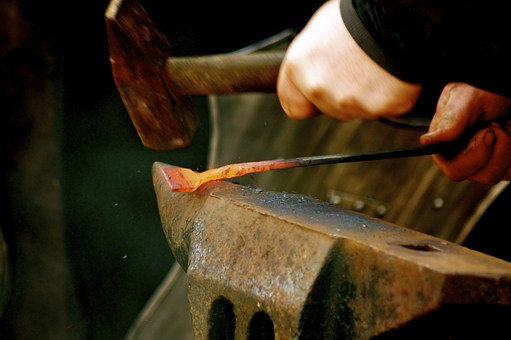Maybe you know the basic tools that blacksmiths use like hammers, anvils, and tongs. But what actual blacksmith techniques are used to shape and mould solid bars of metal into tools and pieces of art?
How do blacksmiths shape and mould metal? In this article you’ll learn some of the important basic techniques that blacksmiths use to create their finished products. Including: Drawing, tapering, peining, bending, upsetting, spreading, punching, slitting, twisting, quenching, welding, tempering, and hardening.
So let’s jump right into it!
Drawing
Drawing is also sometimes called drawing out. It’s a technique used by blacksmiths to reduce the circumference of the material while increasing its length. This blacksmith technique is most often used for forging a point or a taper.
To form a point using the drawing technique, the end of the work is heated until it glows a fiery red color. You then remove the material from the heat and positioned on the anvil with the end slightly tilted up.
Next, use the head of your hammer to strike the end of the metal, while also slightly coming down in an angle to keep the point centered. The metal is then rotated 90 degrees for each strike and then a complete 360 degrees per strike to keep the point centered.
Continue to pound the tip with the hammer until it is as slender as you want or until the end becomes too cool to spread easily. If you keep hitting the metal once it has cooled and no longer allows the metal to shape easily, it can end up breaking the metal. Therefore, once the metal has lost its heat, simply place it back into the heat until it reaches forging temperature. Then continue with the drawing technique.
Sometimes the metal you’re working on is not long enough to hold with your hand. Even the end of the material that is not directly held in the heat can be too hot to touch. In that case, use tongs to hold onto the end while heating the other end.
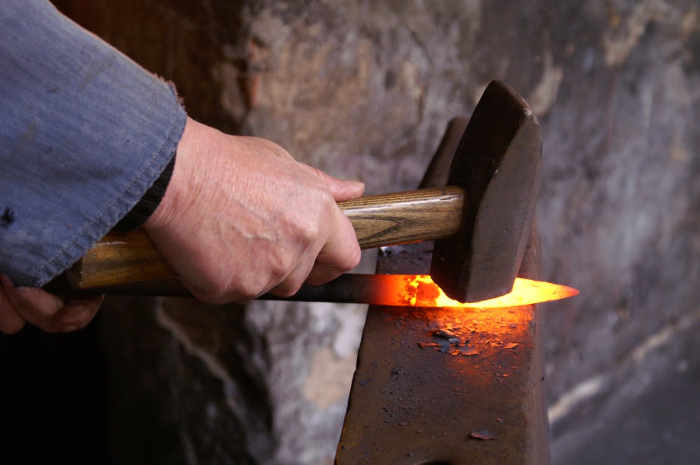
Tapering
A taper is another basic technique used in blacksmithing.
To forge a taper, the end of the material is heated to forging temperature and then brought over to the edge of the anvil. With the end of the material lifted at about a 30 degree angle at the edge of the anvil, the hammer, which should be positioned at about a 30 to 45 degree angle, is then used to strike the end of the bar, rotating the tip first 180 degrees each strike and then 90 degrees each strike to flatten it out, until it eventually forms into a taper. You could also use the horn of the anvil to increase the process.
Be sure to keep the bar positioned on the anvil’s edge to ensure your hammer strikes the bar and not the anvil, which can damage it.
Peining
The back of your hammer contains a little ball shape called a ball-pein. This can be used to move heated metal in various directions; hence the term peining.
This method is often used to create openings through two separate pieces of metal to join them together. However, there are also other types of peins, such as cross-peins, which can be used to create certain textures, designs, and cup shapes.
Bending
To bend metal, simply heat the section of the bar that you wish to manipulate to forging temperature. The more evenly you heat the section of the bar, the easier it is to bend.
Once the section of the bar is evenly heated, grab the unheated ends of the bend,
either with your hands or with tongs, and bend it into the desired shape. You could also use the edges, horns, or holes of the anvil to bend the metal, as well as vises or a bending fork. Use the hammer to lightly finish the bend.
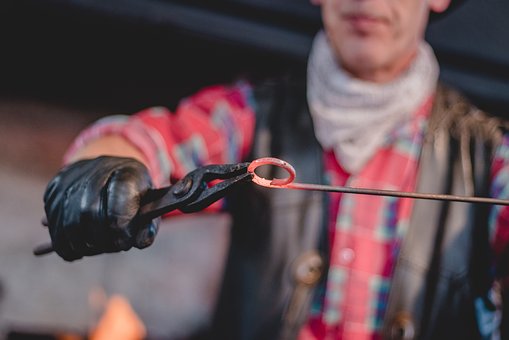
Upsetting
Some shapes, such as a rod, a bar, or a candlestick, require a bit more volume or material at one end, which is where upsetting comes into play.
Upsetting is a blacksmith technique that is used to thicken the circumference of the steel, while also making it narrower or shorter.
During this process, the section to be upset is brought to forging temperature. Then the heated end is either placed onto an upsetting plate, which is a flat plate positioned on the surface that serves as an anvil, or you can simply use an anvil.
The tip of the heated end of the steel is then pressed firmly against the upsetting plate. This uses the steel’s own weight to shape it. Or alternatively you can use a hammer to pound the tip of the heated end into the desired shape.
Spreading
Spreading is the process of increasing the width of the material by reducing the density but keeping the length basically the same.
To do so, bring the section of material to forging heat and then place it on the anvil. Next, take the face of the hammer and using a sweeping action, while pulling the material towards you, strike the material on the edge. Continue this process on the other side, while pulling the material away from you. To keep the spread centered, turn the work 180 degrees every few strikes.
You could also use the cross-pein on the hammer to speed up the process.
Punching
Punching involves cutting through a piece for fastening or design.
During this technique, a punch is used to create the fasten or design. A punch is a hard steel instrument with a specially designed tip at one end and a blunt end on the other.
First, the work is separated into two or more parts then the part to be punched is brought to a forging temperature. The piece is then properly aligned over the anvil’s Hardie hole. The punch is then carefully aligned with the section to be punched, and then the tip of the punch is pounded sharply to create a hole.
Shrinking
When shaping a piece of metal into a complex curve, such as a bowl, the force placed on the smaller radius to stretch causes the metal to develop ripples.
To flatten out the ripples, the metal is compressed between the flat head of the anvil and the flat head of the hammer, also known as shrinking.
This method works particularly best when both the radius of the anvil and the flat head of the hammer match the radius of the object. Which slightly thickens the material thus minimizing the length and evening out the ripples.
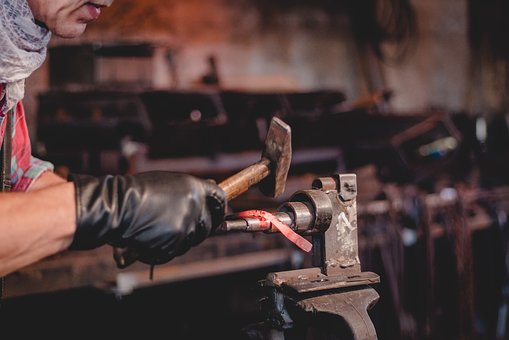
Slitting
Slitting is done by placing the metal on the anvil and then chiseling a slit into it.
Slitting provides a faster and easier way to cut metal than using other tools, such as a bandsaw, especially when working with heated metal. Once the slit is cut and formed into its desired shape, the inner part of the slit is then cleaned, using one of various tools, or you can just lightly forge it on the tip the anvil’s horn.
Twisting
Twists are similar to bends. Only instead of bending the end of the metal into a curve, once you have evenly heated the end of the bar that you want to manipulate to forging heat, you grab hold of the heated end of the bar. And you use a wrench or other tool and manipulate it into a twist.
You can also untwist the metal and try again, provided the piece is still hot enough. Remember, once metal cools to a temperature that is below forging, continuing to manipulate it can cause it to break.
Quenching
Quenching is simply placing heated metal into an ice water bath to cool the piece.
This blacksmith technique is often used to cool one end of the work once it has been shaped. Either in order to work with the other end of the piece, or as a way of making the metal harder for tempering.
Welding
Welding is a fastening method that is used by blacksmiths.
There are various modern welding techniques such as arc welding and gas welding. These require different materials and equipment than your typical blacksmithing calls for. And then there is forge welding, which has been used throughout history.
During forge welding, the workpiece to be joined is first cleaned of scale and rust. It is then heated to the desired welding temperature. The two joint is then held together, and the pieces are forged together.
The key is to heat the material to welding temperature without allowing it to gather any contaminants. Furthermore, the joint needs to be held together and the pieces forged together quickly, so that they do not become cool.
Casting
Casting is different than other blacksmith techniques described so far.
Rather than shaping a piece of metal, a blacksmith can simply melt iron or steel down into a molten state and pour it into a mold to create the object they want.
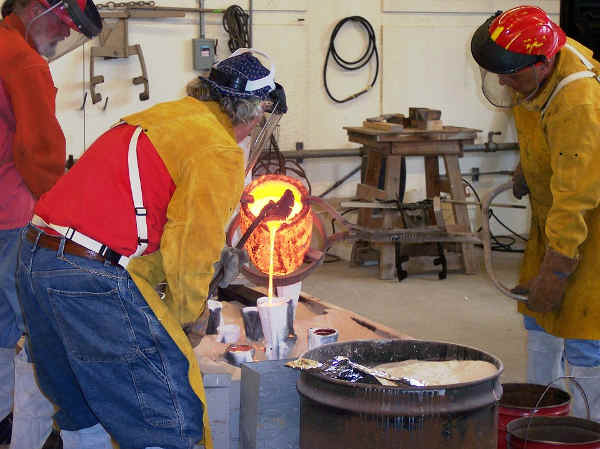
Tempering/Hardening
Tempering and hardening are two common heat treatments used in blacksmithing. They’re used to increase strength.
Tempering
During tempering, also called drawing the temperature, a good sharp edge is put on a piece of metal to make it hard enough to withstand heavy striking.
The metal’s face is brought to a shine by polishing it. The metal is then heated slowly to increase its durability where needed. Once the heat hits the polished section of the metal, it causes the metal to change various colors. Different colors signify the various degrees of hardness, until it reaches the desired strength.
The process of tempering can be repeated to increase its resilience.
Hardening
Hardening, also called quenching the material, is when metal is heated until it is fiery red and then submerged in water. The key is to submerge the metal into the water straight, which helps prevent distortion. Oil or salt is also sometimes added to the water to slow down the cooling process. This helps prevent the metal from becoming too brittle or twisted out of shape.
Blacksmith Techniques – Related Questions
What Tools Does A Beginner Blacksmith Need?
To get started with blacksmithing, you’ll need a forge to heat up your work. As well as a hammer to apply most of the techniques we discussed in this article, and an anvil to hit it on. You’ll also want tongs or a vice to hold your work while it’s too hot to touch.
What Does A Blacksmith Make?
Blacksmiths can shape iron and steel into all kinds of different items. They can make tools like hammers, chisels, axes, hoes, and shovels. They can create hardware such as hinges and handles for doors, hooks to hang things on, and nails. As well as larger decorative pieces like iron gates or staircase railings. In the past, a blacksmith was often busy making armor and weapons as well.
Where Do Blacksmiths Work?
Blacksmiths typically have a dedicated workshop where they do their work. It will contain a forge or furnace to heat up their work, an anvil to work on, and all the tools that they need. A blacksmith’s workshop typically has a strong smell of molten iron and coal dust.
What blacksmith techniques do you most commonly use? Let us know in the comment section below!

